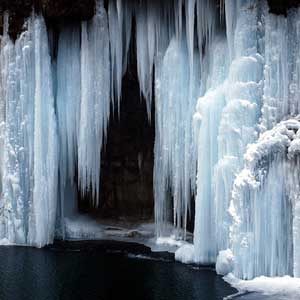Facts about Ice
Posted by A. Douglas / in Science Facts

Learn some facts about ice. Even though many liquids can freeze, ice is generally considered the frozen form of water. This is the solid phase of water.
Unit Weight of Ice
Ice weighs approximately 57.4 pounds per cubic foot (919.46 kg per cubic meter) which is less than the liquid form of water. Liquid water weighs 62.4 pounds per cubic foot (999.55 kg per cubic meter). This is the reason why ice floats in water. It is lighter than water!
Ice Facts: Freezing Temperature from Water to Ice
Pure water under normal atmosphere conditions freezes at a temperature of 32° F (0° C) to form ice.
Road maintenance crews use salt on roads when freezing roads are expected. The salt lowers the freezing temperature to about 15° F (-7° to -8° C). Snow and ice melt from roads when the temperatures are higher than this range.
When water turns to ice the volume grows about 8.7 percent. The expanding size of ice is what allows ice to float on water. Expanding ice also causes problems. When water seeps into cracks in buildings, soils or roads and then freezes it expands. This can cause big problems with these items in cold climates. In the spring and late fall, warm temperatures during the day melt ice. At night the water freezes again. This freezing and thawing is the most damaging time of year from ice expansion.
Ice Facts: Ice Inventors
Obviously, people did not invent ice. Ice is a fact of nature on earth, especially in the colder parts of the Earth, near the poles. However, there are inventors who found ways of making ice, even when the temperature outside is warm.
William Cullen from the University of Glasgow was the first to demonstrate artificial cooling, which was the first step to an artificial ice maker. In the late 1800s there were working models of artificial refrigeration, but these machines used toxic chemicals to achieve cold temperatures. In 1928, Freon was developed by Thomas Midgley, Jr. and Charles Franklin Kettering, which brought refrigerated ice boxes to many households.
In 1949 Frank Zamboni patented his ice refinishing machine. Before Zamboni's machine, it took several men hours to scape off the ice marked by ice skates, the pour water to create a new smooth surface. Zomboni's machines are still used today all most major ice rinks.
Ice Facts: Playing it Safe on Ice
The way to walk on water is to walk on ice. Pure, clear ice is generally safe to walk on if it is 4 inches or more thick the ice is over stagnant water, such as a pond. Before walking on ice you need to have someone who knows how, check the ice thickness to make sure it is safe. If the ice is cloudy or "white ice" then the ice thickness needed doubles to 8 inches thick.

